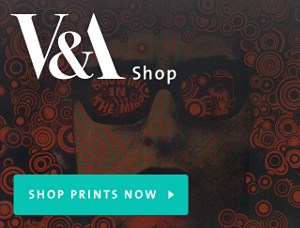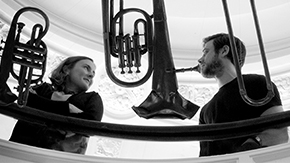
'January', from 'The Months', watercolour by Robert Dighton, Great Britain, about 1785. Museum no. E.33-1947
Most of these designs were bequeathed to the Museum as a group in 1973. Nothing is known of their origin and provenance, but they appear to have come from the archive of an 18th-century retailer based in London. They were intended for use on the light muslin gowns, petticoats and aprons that were so fashionable at the period.
The designs are clearly the work of a professional pattern drawer. Many such designers worked in London, retailing their work through linen drapers and lacemakers. The patterns would have been used by professional embroiderers, but also by amateurs, buying or borrowing them from the retailer.
Hand-written inscriptions suggest how the designs might have been used, and by whom. Many relate to a network of wealthy friends and relations, including Lady Middleton, who lived in the country but came up to London for the season.
'Lady Middleton's pattern' is a key to revealing a whole web of relationships within a group of neighbours and relatives in East Sussex.
Lady Middleton was born Frances Pelham, the daughter of the 1st Earl of Chichester, of Stanmer Park near Brighton. She married in 1778 and died in childbirth in 1783. Her sister Emily is also mentioned in the inscriptions. Another sister, Lucy, married the 1st Earl of Sheffield, of nearby Sheffield Place, in 1794. Lucy's stepdaughter, Maria Josepha Holroyd, is also named on the patterns and was a friend of Miss Thrale. It is clear from the inscriptions that these women were willing to share an embroidery design with a friend or relative.

Design for embroidery for a petticoat and open gown, 1782–94. Museum no. E.237-1973.
Design for embroidery for a petticoat and open gown
England
1782–94
Bequeathed by Raymond Johnes
Museum no. E.237-1973The pinholes, not following the lines of the design but scattered all over the sheet, suggest that the design was once pinned to a piece of muslin or gauze on a round tambour frame. The vertical design is similar to that on a white muslin gown of about 1800 displayed in the British Galleries (Room 120).

Two designs for embroidered borders to petticoats and open gowns, 1780s. Museum no. E.246-1973
Two designs for embroidered borders to petticoats and open gowns
England
1780s
Pen and ink on laid paper; with fold marks
Inscribed in pen and ink on the back,‘I have not worked these but I thought mayhaps you might like them – Return all when you Have done with them’
Bequeathed by Raymond Johnes
Museum no. E.246-1973Here, the inscription and fold marks indicate that the design was sent out. The design at the bottom has a pointed edge known at the period as ‘Vandyke scollop’, after costume in portraits by the 17th-century painter Anthony van Dyck.

Design for embroidery for an apron for Miss Thrale, Anonymous
Design for embroidery for an apron for Miss Thrale
Anonymous
England
1788
Pen and ink on laid paper
Bequeathed by Raymond Johnes
Museum no. E.227-1973Miss Thrale was Hester Thrale (1764–1857), known as ‘Queeney’. Her father was a wealthy brewer and her mother the celebrated and clever Mrs Thrale, a friend of Dr Samuel Johnson, the author and lexicographer.

Design for embroidery for an apron, Anonymous. Museum number E.228-1973
Design for embroidery for an apron
Anonymous
England
Pen and ink on laid paper
Bequeathed by Raymond Johnes
Museum number E.228-1973The similarity of the seaweed-like pattern on this design and that for Miss Thrale's apron shows that one pattern-drawer, or perhaps an assistant in the same workshop, designed both.

Design for embroidery for a border to a petticoat and open gown, Anonymous. Museum number E.261-1973
Design for embroidery for a border to a petticoat and open gown
England
1780s
Pen and ink on laid paper
Bequeathed by Raymond Johnes
Museum no. E.261-1973The front edge of the paper has been sewn onto a backing sheet to strengthen it. This, and the many pinholes, suggests that the design must have been used many times. The grid of pinholes shows how the design was tacked to muslin or gauze on a tambour frame.

Petticoat to, or panel from the skirt of
Petticoat to, or panel from the skirt of, an open gown (detail)
England
1780's
Embroidered in chain stitch, in coloured silks, with drawnwork on muslin
Private collector
Design for embroidery for a petticoat and open gown, or for an apron
Design for embroidery for a petticoat and open gown, or for an apron
England
1780s
Pen and ink on laid paper
Bequeathed by Raymond Johnes
Museum no. E.269-1973This design closely resembles another in the London archive. Presumably both are the work of the same pattern drawer.

Design for a petticoat to an open gown, Anonymous
Design for a petticoat to an open gown
Anonymous
England
1789
Pen and ink on laid paper, stitched with two different types of thread
Inscribed in pen and ink on the back,‘Mrs Henry Foster worked in Purple silk in Cobble stich for a petticoat to a white Gause gown July 5th–1789’
Bequeathed by Raymond Johnes
Museum numbers E.230-231-1973The inscription may suggest that Mrs Henry Foster was a professional embroiderer, and that the workshop was noting the technique used by one employee to instruct another. Alternatively, it may mean that she was an amateur who had once hired the pattern, and that it was now on loan to someone else who needed further guidance.

Designs for embroidered borders to aprons, 1780s. Museum no. E.251-1973
Designs for embroidered borders to aprons
Anonymous
England
Pen and ink on laid paper
Bequeathed by Raymond Johnes
Museum number E.251-1973There are two designs on this sheet of paper arranged with one at each end. The borders are for the right-angled corners of aprons with scalloped edges.

Design for embroidery for a petticoat and open gown, or for an apron
Design for embroidery for a petticoat and open gown, or for an apron
Anonymous
England
Pen and ink on laid paper
Bequeathed by Raymond Johnes
Museum no. E.252-1973The design is unfinished at one end but the repeat indicates that it continues to the borderless edge. The skilful drawing of the repeat suggests that the design is the work of a professional pattern drawer.

Design for an embroidered border for a petticoat and open gown, 1780s. Museum no. E.257-1973
Design for an embroidered border for a petticoat and open gown
England
1780s
Pen and ink on wove paper
Bequeathed by Raymond Johnes
Museum no. E.257-1973The undulating stem with leaves along the top of the design is similar to one published in 'The Fashionable Magazine' (‘Pattern for a Train, Drawn by Mr Styart’, plate iv, vol. 1, 1786).
Techniques
The designs are pierced with pinholes indicating that they were pinned or tacked to fabric stretched on a tambour or embroidery frame. The patterns are in pen and ink so that they could be seen through muslin or gauze.
According to Saint-Aubin who described whitework embroidery in his 'L'Art du Brodeur', published in 1770, the design was never drawn directly onto the material but 'with small stitches one bastes the muslin over the design which has been drawn on paper or parchment.' The embroiderer could then work directly from the design beneath.
These designs are not pricked and pounced wherein the lines of the design are pricked and then the surface rubbed with powder transferring the pattern through the pinholes to the textile beneath (pouncing). The lack of pricking and pouncing shows that these designs are for embroidery on muslin.
Professional design and embroidery
Both amateurs and professionals used the technique of tacking designs to muslin or gauze on a tambour or embroidery frame. Most, if not all, of the clients whose names are inscribed on the designs could have used them to embroider from themselves because elite women were accomplished at needlework.
In some cases, these designs could have been embroidered professionally for the clients as a ready-made dress. The patterns have a client's name instead of a number for cross-reference with a client book. This numberless system suggests a business with an easily identifiable clientele and a personal service.

Become a V&A Member

V&A Members enjoy a wealth of benefits, including free entry to exhibitions, previews, exciting events and the V&A Members’ Room. In addition, you will be supporting the vital work of the V&A.
Buy or Renew Membership Online






